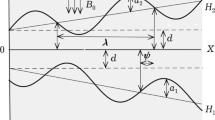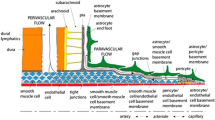Abstract
In this paper, we focused on the flow through an axisymmetric constricted artery of the pulmonary region to study the condition of stenosis. Theory of dust particles suspended in gas is applied on blood flow through the artery, where the “particles” represent “cells” suspended in plasma. The flow is governed by two dimensional Navier–Stokes’ equations by including Darcy–Forchheimer drag force caused by non-Darcian effect. The material of the artery is approximated as a linear elastic and simplest rheological equation that includes viscosity and elasticity (considered lung as a Voigt body) is used. Effect of various parameters, such as Reynolds number (Re), Forchheimer number (\(F_s\)), Darcy number (Da), aspect ratio (\(\beta \)), shape factor (\(S_f\)), porosity (\(\epsilon \)), aerodynamic diameter (\(d_p\)), bulk compression (\(\phi \)) of elasticity, shear (\(\eta \)) and bulk (\(\zeta \)) coefficients of parenchymal viscosity are obtained on the radial and axial velocities of blood and particles graphically. We found that the fluid (blood) and particle (cells suspended in plasma) velocities along both the axes (axial and radial) increase by increasing Reynolds number, the pulsating amplitude, aspect ratio, and porosity of walls. While by increasing Forchheimer number, velocities of blood and particles in both the axes decreases gradually. The present analysis is also indicate that the viscoelasticity of walls are affected by the amplitude of pulsatile flow of blood and for a large value of amplitude, the viscoelastic effect decreases.








Similar content being viewed by others
References
Al-Mayah, A., Moseley, J., Brock, K.K.: Contact surface and material nonlinearity modeling of human lungs. Phys. Med. Biol. 53(1), 305–317 (2008)
Alimohamadi, H., Imani, M.: Finite element simulation of two-dimensional pulsatile blood flow through a stenosed artery in the presence of external magnetic field. Int. J. Comput. Methods Eng. Sci. Mech. 15(4), 390–400 (2014)
Chandran, K.B., Swanson, W.M., Ghista, D.N., Vayo, H.W.: Oscillatory flow in thin-walled curved elastic tubes. Ann. Biomed. Eng. 2, 392–412 (1974)
Darcy, H.: Les fontaines publiques de la volle de dijon. Dalmont, V, Lyon Public Library (1856)
Dyachenko, A.I., Lyubimov, G.A.: Propagation of sound in pulmonary parenchyma. Plenum Publ. Corp. N Y Washington 23, 641–652 (1988)
Dyachenko, A.I., Manyuhina, O.V.: Modeling of weak blast wave propagation in the lung. J. Biomech. 39(11), 2113–2122 (2006)
Eom, J., Xu, X.G., De, S., Shi, C.: Predictive modeling of lung motion over the entire respiratory cycle using measured pressure-volume data, 4dct images, and finite-element analysis. Med. Phys. 37(8), 4389–4400 (2010)
Fuchs, N.A.: The mechanics of aerosols. American Association for the Advancement of Science (1994)
Fulford, G.R., Blake, J.R.: Muco-ciliary transport in the lung. J. Theor. Biol. 121(4), 381–402 (1986)
Fung, Y.C.: A theory of elasticity of the lung. J. Appl. Mech. 41(1), 8–14 (1974)
Hinds, W.C.: Aerosol Technology: Properties, Behavior, and Measurement of Airborne Particles, 2nd edn. Wiley, London (1999)
Ilegbusi, O.J., Seyfi, B., Salvin, R.: Patient-specific model of lung deformation using spatially dependent constitutive parameters. Math. Comput. Model. Dyn. Syst. 20(6), 546–556 (2014)
Jahed, M., Lai-Fook, S.J., Bhagat, P.K., Kraman, S.S.: Propagation of stress waves in inflated sheep lungs. J. Appl. Physiol.: Respir. Environ. Exercise Physiol. 66(6), 2675–2680 (1989)
Khaled, A.R.A., Vafai, K.: The role of porous media inmodeling flowand heat transfer in biological tissues. Int. J. Heat Mass Transf. 46(26), 4989–5003 (2003)
Khanafer, K., Cook, K., Marafie, A.: The role of porous media in modeling fluid flow within hollow fiber membranes of the total artificial lung. J. Porous Media 15(2), 113–122 (2012)
Kumar, B.V.R., Naidu, K.B.: A pulsatile suspension flow simulation in a stenosed vessel. Math. Comput. Model. 23(5), 75–86 (1996)
Lee, T.S., Liu, X., Li, G.C., Low, H.T.: Numerical study on sinusoidal fluctuated pulsatile laminar flow through various constrictions. Commun. Comput. Phys. 2(1), 99–122 (2007)
Liu, B., Tang, D.: Computer simulations of atherosclerotic plaque growth in coronary arteries. Mol. Cell. Biomech. 7(4), 193–202 (2010)
Mehmood, O.U., Mustapha, N., Shafie, S.: Unsteady two-dimensional blood flow in porous artery, with multi-irregular stenoses. Transp. Porous Media 92(2), 259–275 (2012)
Murphy, M.J., Pokhrel, D.: Optimization of an adaptive neural network to predict breathing. Med. Phys. 36(1), 40–47 (2009)
Ozkaya, N., Nordin, M., Goldsheyder, D., Leger, D.: Fundamentals of Biomechanics: Equilibrium, Motion, and Deformation, 3rd edn. Springer, New York (2012)
Ponalagusamy, R.: A two-layered suspension (particle-fluid) model for non-newtonian fluid flow in a catheterized arterial stenosis with slip condition at the wall of stenosed artery. Korea-Australia Rheol. J. 29(2), 87–100 (2017)
Preziosi, L., Farina, A.: On darcy’s law for growing porous media. Int. J. Non-Linear Mech. 37(3), 485–491 (2002)
Reddy, J.V.R., Srikanth, D., Mandal, P.K.: Computational hemodynamic analysis of flow through flexible permeable stenotic tapered artery. Int. J. Appl. Comput. Math. 3(1), 1261–1287 (2017)
Saffman, P.G.: On the stability of laminar flow of a dusty gas. J. Fluid Mech. 13(1), 120–128 (1962)
Saini, A., Katiyar, V.K., Parida, M.: Two dimensional model of pulsatile flow of a dusty fluid through a tube with axisymmetric constriction. World J. Model. Simul. 12(1), 70–78 (2016)
Sankar, M., Do, Y.: Numerical simulation of free convection heat transfer in a vertical annular cavity with discrete heating. Int. Commun. Heat Mass Transf. 37(6), 600–606 (2010)
Sankar, M., Kim, Beomseok, Lopez, J.M., Do, Younghae: Thermosolutal convection from a discrete heat and solute source in a vertical porous annulus. Int. J. Heat Mass Transf. 55, 4116–4128 (2012)
Sankar, M., Kiran, S., Ramesh, G.K., Makinde, O.D.: Natural convection in a non-uniformly heated vertical annular cavity. Defect Diffus. Forum 377, 189–199 (2017)
Sankar, M., Park, J., Do, Y.: Natural convection in a vertical annuli with discrete heat sources. Numer. Heat Transf. Part A: Appl. 59(8), 594–615 (2011)
Sankar, M., Park, Youngyong, Lopez, J.M., Do, Younghae: Numerical study of natural convection in a vertical porous annulus with discrete heating. Int. J. Heat Mass Transf. 54, 1493–1505 (2011)
Smith, G.D.: Numerical Solution of Partial Differential Equations, 3rd edn. Oxford University Press, USA (1986)
Sorek, S., Sideman, S.: A porous medium approach for modelling heart mechanics. Math. Biosci. 81(1), 1–14 (1986)
Sturm, R., Hofmann, W.: A theoretical approach to the deposition and clearance of fibers with variable size in the human respiratory tract. J. Hazard. Mater. 170(1), 210–218 (2009)
Vankan, W.J., Huyghe, J.M., Janssen, J.D., Huson, A., Hacking, W.J.G., Schrenner, W.: Finite element analysis of blood flow through biological tissue. Int. J. Eng. Sci. 35(4), 375–385 (1997)
Weibel, E.R.: Morphometry of the Human Lung, chapter Introduction, pp. 1–4 (1963)
Wong, K.K.L., Tu, J., Mazumdar, J., Abbott, D.: Modelling of blood flow resistance for an atherosclerotic artery with multiple stenoses and poststenotic dilatations. ANZIAM J. 51, 66–82 (2010)
Zendehbudi, G.R., Moayeri, M.S.: Comparison of physiological and simple pulsatile flows through stenosed arteries. J. Biomech. 32(5), 959–965 (1999)
Acknowledgements
The author, Jyoti Kori, is thankful to Ministry of Human Resource Development (Grant Code:- MHR-02-23-200-44) India for providing fund and support while writing this manuscript.
Author information
Authors and Affiliations
Corresponding author
Ethics declarations
Conflict of interest
No conflict of interest.
Additional information
Publisher's Note
Springer Nature remains neutral with regard to jurisdictional claims in published maps and institutional affiliations.
Rights and permissions
About this article
Cite this article
Kori, J., Pratibha Analysis of the Flow Dynamics of Blood Through Viscoelastic Constricted Artery. Int. J. Appl. Comput. Math 6, 41 (2020). https://doi.org/10.1007/s40819-020-0796-7
Published:
DOI: https://doi.org/10.1007/s40819-020-0796-7




